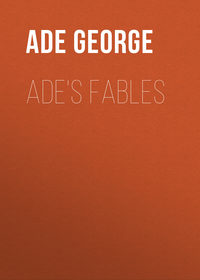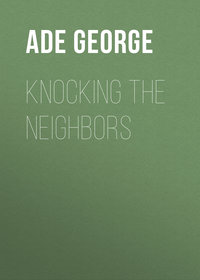
In Pastures New
It is all different in Egypt. The greatest indignity that a Mohammedan ever offers a fly is to give him a gentle shove and request him to move on. It is contrary to the religious teachings to kill or even cripple this diminutive household companion. The belief in the transmigration of souls seems to prevail everywhere in the mystical East, and perhaps the fly that follows and nags you all afternoon may harbour the spiritual essence of a former head waiter or a bey or some other dignitary. When the flies assemble in large numbers around the various apertures of a baby's face, the child, obeying an instinct of self-defence, tries to "spat" them and drive them away. But the mother restrains the infant by holding its hands and the flies give themselves over to unmolested enjoyment. The older children have learned their lesson and seldom make any effort to brush away the flies which loiter all over their bright young features. This is not a pleasant thing to talk about, but inasmuch as the fly is omnipresent during a trip up the Nile and this friendly understanding between the fly and the native is constantly under the traveller's observation, a description of Egypt would be sadly incomplete without a chapter on the fly.
Having been a privileged class for many generations, the flies are impudent and familiar to a degree. When the white unbeliever, with no conscientious scruples against murder, comes up the river, they swarm about him and buzz into his ears, "Welcome to our city." Then when he begins sparring with them and using sulphurous language, they gather about him in augmented numbers and dodge when he strikes and side step when he slaps himself and seem to think that he is trying to teach them some new kind of a "tag" game. The Mohammedan fly cannot by any effort of the imagination bring himself to believe that a human being would wilfully injure him. This feeling of overconfidence in mankind breeds carelessness, and during the open season for tourists many of them are laid low. Mr. Peasley said that if there was anything in the transmigration theory, he figured that he had massacred a regiment of soldiers, several boards of directors, a high school and an insane asylum. The mortalities during the tourist season do not seem to lower the visible supply or in any way discourage the surviving millions.
When we started up the river a peddler came to the boat and offered us some small fly brooms. They are very much like the brush used by the apprentice in a blacksmith shop to protect the horse that is being shod. The brush part is made of split palm leaves or horsehair and the handle is decorated with beadwork. The idea of a person sitting about and whisking himself with this ornamental duster struck us as being most unusual, not to say idiotic. Before we travelled far up the Nile we had joined the grand army of whiskers. The fly broom is essential. It is needed every eight seconds. At Luxor we went out to see a gymkhana under the auspices of the Luxor Sporting Club and every one of the two hundred spectators sat there wearily slapping himself about the head with the tufted fly brush while looking at the races.
The Luxor Sporting Club is not as dangerous as it sounds. The presiding judge of the races was a minister of the gospel and the receipts were given to local charities. A gymkhana is the last resort of a colony shut off from the metropolitan forms of amusement, and yet it can be made the source of much hilarious fun. Nothing could have been more frivolous than the programme at Luxor, and yet the British spectators seldom gave way to mirth. Doubtless they were laughing inwardly. Several ponderous committees had charge of the arrangements and attended to them with due solemnity.
First there was a race between native water-carriers, distance about three hundred yards, and each contestant carrying a goat skin filled with water. Then there was a donkey boys' race, each rider being required to ride backward. This enabled him to encourage his mount by twisting the tail. In the donkey race for ladies several of the contestants fell off gracefully and were carried to the refreshment booth, where they revived on tea. The "affinity race" was an interesting feature. The contestants rode their donkeys in pairs, a gentleman and a lady holding a long ribbon between them. They were required to gallop about two hundred yards, turn a post, and return to the starting point without letting go of the ribbon. By far the most exciting features of the programme were the camel and buffalo races. These animals have associated with the hysterical natives so long that they have lost all of their natural horse sense and are quite daft and irresponsible. At the word "Go!" instead of running down the course, they would snort madly and start off in all directions. If any of them finished under the wire it was by mere chance and not because of any guiding intelligence. One demented water buffalo turned and ran at right angles to the course. The last we saw of him he was disappearing over a hill toward the setting sun, with the native jockey riding on all parts of the upper deck, from the horns back to the tail.
The gymkhana is intended to provide an afternoon of undiluted nonsense, and for the benefit of those who find reason tottering on her throne and who don't care what they do as long as they enjoy themselves, I shall append a few sample competitions from an Egyptian programme and suggest that they be tried in America.
Bucket Contest – Competitors to gallop past three buckets, throwing a potato into each bucket. Marks to be given for pace. Best of two runs.
Hat Trimming Competition – Gentleman to ride to lady with parcel containing hat and trimmings. Lady to trim hat and gentleman to return to the winning post wearing hat.
Dak Race – Competitors to drive at the trot about one-half mile, unharness and saddle same pony and ride 200 yards, returning to the winning post.
Housekeeping Stakes – Gentleman on side saddle to ride to lady and give her envelope containing an addition sum. Lady to open envelope, add up this sum and return it to gentleman. First past the post with correct sum wins.
Needle Threading Competition – Lady carries needle and thread 100 yards to gentleman partner. He threads the needle and returns it to lady. First past the post with needle properly threaded wins.
Egg Carrying Competition for Ladies – Each lady carries an egg in an ordinary teaspoon for a distance of about fifty yards. If egg is dropped it must be recovered with the spoon and must not be touched with the hands. First past the post with unbroken egg wins.
There are many other contests which tax the intellect in a similar manner, but possibly the foregoing will be sufficient to provide a fairly demoralising afternoon. Of course, in America it is impossible to secure the real Levantine donkey. In Egypt the donkey takes the place of the motor car, the trolley, the hansom, and the bicycle. In size he ranges from an average goat to a full grown St. Bernard. Ordinarily he is headstrong and hard to manage, having no bridle wisdom whatever, but he is of tough fibre and has a willing nature, and behind his mournful countenance there always seems to be lurking a crafty and elusive sense of humour. The names are marvellous. At the various stops on our way up the Nile I became personally acquainted with Rameses the Great, Rameses Telegraph, Rameses Telephone, Jim Corbett, Whiskey Straight, Lovely Sweet, Roosevelt, Sleeping Car, Lydia Pinkham, and others equally appropriate which I cannot now recall.
As I have indicated above, our wanderings have carried us as far as Luxor. Luxor (the ancient Thebes) is the superlative of all that is old and amazing in Egypt and therefore it calls for at least one separate chapter.
CHAPTER XVII
IN AND AROUND LUXOR, WITH A SIDE
LIGHT ON RAMESES THE GREAT
Until we arrived at Luxor we did not know the total meaning of the word "old." The ruins, which are the stock in trade of this ancient City of Thebes, date so far back into the dimness of Nowhere that all the other antiquities of earth seem as fresh and recent as a morning newspaper.
"Old" is merely a relative term, after all. I remember in my native town we small boys used to gaze in reverent awe at a court house that was actually built before the Civil War. We would look up at that weather-beaten frame structure, two stories high, with a square bird cage on top of it, and to us it had all the historic interest of a mediæval castle. Later, in Chicago, when the special writer on the newspaper ran short of topics he would dish up an illustrated story on the oldest building in town. It was constructed away back in 1833.
When a man from the West goes East for the first time and sees Independence Hall in Philadelphia, he takes off his hat and tries to grasp the overwhelming fact that the building stood there even in the far distant Colonial period. When he travels to London and walks through St. Paul's or stands in the Henry VII. Chapel at Westminster he begins to get a new line on the meaning of "old." Later he sees the Forum at Rome and declares to himself: – "At last I have found something really ancient."
But when he arrives at Luxor and rambles among the elephantine ruins and sits in the deep cool shade of temples that had been standing a good many centuries before anyone thought of laying out the Forum in Rome he will begin to understand how everything else in the world is comparatively hot from the griddle. One day we were in the shop of Mouhammed Mouhassib, in Luxor, and the old antiquarian reached under the counter and lugged out a mummy. The body was well preserved, and the embalming cloth in which it was wrapped and cross-wrapped still retained a definite texture.
"This mummy dates back beyond any of the dynasties of which we have a record," said the dealer. "There were no inscriptions on the mummy case, because when this gentleman lived it was not the custom to inscribe the cocoon. You will observe, however, that he was buried in a sitting posture, and we know that this manner of burial was discontinued about 6000 B.C."
As we stood there gazing into the calm features of the unidentified has-been and realised that he had been sitting in that easy attitude for eight thousand years waiting for us to come along and be presented to him, we began to get a faint inkling of what the word "old" really means.
Goodness knows I am not going to attempt any detailed description of the stupendous ruins which make Luxor the most interesting spot in Egypt. Anyone who is going to describe Luxor needs a new box of adjectives every few minutes, and, besides, to repeat over and over again that the columns and cavernous sanctuaries at Karnak are "gigantic," and "colossal," and "huge," and so on, cannot bring the reader to any actual conception of the barbaric massiveness of these ancient structures.
The rulers who built the main temple of Karnak, a section at a time, thought they were not doing themselves credit unless they piled up columns about the size of the redwood trees in California and guarded each entrance with statues as big as the Goddess of Liberty in New York Harbour, and when they made a wall to enclose a courtyard, they put up something to resemble a mountain range. The ordinary 150 pound mortal edging his way through the corridors and under the vast shadows of these overwhelming uplifts of masonry feels about as large and as important as a gnat.
Everywhere about these temples there are uniformed guards whose duty it is to protect the remains against the vandal and the relic hunter. The guard follows a few feet behind you as you roam through the many acres of toppling ruin. He is afraid that you will steal something. Inasmuch as the smallest fragment of one of these huge statues, or obelisks, would weigh probably six hundred pounds, we felt that he was not justified in suspecting us. But he followed along and then, when we were leaving, he calmly came forward and indicated that he was ready to take a money insult. This move on his part was most characteristic of the Egyptian attitude toward visitors in general. Every native expects to get something out of a traveller for the simple reason that he needs the money. Suppose that a suspicious character should arrive in an American city and the chief of police sent out a detective to shadow him and see that he did not blow open any safes or crawl into any second stories. The detective, having followed the suspect all day, approaches him at nightfall and says, "Look here; you have put me to a lot of trouble. I have been on my feet all day watching you for fear that you were going to commit a burglary, and I think it is only right that you should pay me something."
Every time we visited an antiquity these guards tagged at our heels, watching us like hawks, and invariably they tried to hold us up for a piece of silver before we departed. There is a Masonic understanding among the natives that the tourist is to be fleeced. For instance, although the copper coins are in common use among the natives, and in the cheaper shops the prices are usually reckoned in milliemes, it is almost impossible for a traveller to get any of these copper coins because the natives want him to bestow his gratuities in piastres. A millieme is worth one-half cent, and then the millieme is further subdivided into fractional coins, some of which are about the size of the mustard seed and worth about as much as a share of mining stock.
Egyptian money is very easily understood by Americans. The piastre is the same as our five-cent piece or nickel. The silver five piastre piece resembles our quarter and has the same value. The ten piastre piece is the same as our half-dollar. The 100 piastre bill is worth five dollars. Inasmuch as many of the prices sound large and important when quoted in piastres, the dealers have learned to demand English pounds sterling or American dollars. That is, they name their first prices in sovereigns and dollars and then gradually work down to piastres. I saw a native trying to sell a scarab to a tourist. His first price was £7, equivalent to $35. After a half-hour of haggling he had cut it to 7 piastres, or 35 cents, and the deal was consummated.
The old city of Thebes was a huge and hustling metropolis, surrounded by a high wall of a hundred gates, with countless regiments of soldiers marching out to conquer distant lands and bring back slaves in little batches of 80,000 or so. This was along about 2000 B.C. The city began to lose some of its importance a few centuries before the Christian era and dwindled in size until twenty years ago it was a mere village of huts nestling in the shade of the great temples. Then the tourist travel set in very heavily, and to-day Luxor is a hustling city with large hotels and fancy shops and a general air of prosperity. The magnificent temple of Luxor is in the very heart of the new city. The rambling temple of Karnak is a short donkey ride to the north, and across the river, some three miles to the west, there are more temples and shattered statues and the wonderful tombs of the kings. In olden days there was a broad avenue leading north to Karnak and thence west to the valley in the desert, where the kings were buried, and this boulevard was guarded on either side, for the entire distance, by huge recumbent Sphinxes carved out of granite. Can you imagine a double row of gigantic figures crouched on each side of the street and about twenty feet apart all the way up Broadway to Central Park and then through the Park to Riverside Drive and up the drive to the distant suburbs? If so, you will understand to what an extent these old rulers "went in" for sphinxes. Labour cost nothing and time did not count for anything and if a king wished to build an avenue of sphinxes leading to his private temple or tomb all he had to do was to give the word.
As soon as a king mounted the throne he began making his funeral preparations, and ordered the entire staff of stone cutters to chisel out hieroglyphs explaining that he was great and good and just, and that he never took off his hat to anyone except the gods, and then not ordinary picayune gods, but only those of the very first magnitude. According to the hieroglyphs, every king that ruled in Egypt was as wise as Solomon, as brilliant in military strategy as Napoleon, and as hard on the evildoer as our own beloved T.R.
This unanimous outpouring of eulogy is largely explained by the fact that every memorial in honour of a ruler was erected and supervised by that ruler himself. It's a fact! Of all the countless temples and obelisks and godlike granite figures and festal tomb chambers remaining in Egypt to testify to the majesty and splendour of the ancient dynasties, every one was built under the personal supervision of the man who gets all of the glory out of the inscriptions. The succeeding generation never got up subscription lists to build monuments to statesmen or military commanders. The dutiful and loving son never ordered a memorial in honour of his illustrious father. He was too busy carving his own biography on the sandstone and depicting himself as pursuing the enemy or taking afternoon tea with haughty three-headed gods.
In old Egypt every king was his own press agent. These rulers could have written some great "personal recollections" for the magazines, because they remembered all the incidents that brought them to the centre of the stage with the calcium turned on, and wisely forgot all details calculated to injure their standing with posterity.
You take Rameses the Great. He is regarded as perhaps the king pin of all the rulers during Egypt's long period of national splendour. Have you ever heard anyone say a word in criticism of Rameses' fiscal policy, his treatment of the rebate system, management of the Senate, or his social relations with the dark emissaries that came up from Nubia? No! Everyone has a good word for Rameses. The writers of ancient history extol him, and the guide books print his name in big black letters, and the travellers to Egypt gather about his glass-covered coffin in the Ghizeh Museum at Cairo and try to trace noble lineaments in the shrunken features. They sigh over his departure and look down at him mournfully, with their hats in their hands, as if they had lost him this spring, instead of 3164 years ago this spring. They say: – "Well, he certainly was a grand character and it's too bad we haven't got some rulers of his calibre nowadays."
It is not my desire to attack Rameses, but I feel it my duty to submit to students of history and archæologists a very interesting papyrus, which came into my possession at Luxor. If this document is accepted as authentic and the statements are believed, then it would appear that Rameses was the champion advertiser of ancient times. If Rameses were alive to-day he would own all the billboards in America. He would take a full page in every Sunday paper and have his picture on free calendars. He would give Lawson cards and spades.
In all accepted records discovered up to this time Rameses has received nothing but praise. Why? Because all the records were doctored by Rameses himself. He was the great builder of Egypt and all over the walls of every building that he erected he had his picture and tales of his mighty achievements blazoned forth in bright colors like the row of banners in front of a side show. Wherever in Egypt he could find a large smooth-faced rock he would engage a member of the Royal Academy to sculp something about Rameses, and he would always stand and look over the sculptor's shoulder to make sure that the king didn't get the worst of it. If the army of Rameses suffered a defeat at the hands of the Hittites, did any mention of the fact find its way into the inscriptions? Most assuredly not. Rameses had the hieroglyphs report that he made a masterly manoeuvre in order to develop the strength of the enemy and then retired to a new and more strategic position.
We cannot discover from the old inscriptions that any Egyptian army ever suffered defeat, and yet it has been learned from other sources that now and then an invading army had the whole native population running foot races up and down the Nile. However, it was not considered good form for historians to mention these painful incidents. The rate of mortality among those who criticised the administration was exactly 100 per cent. It is because all of the familiar records are known to have been under censorship that the papyrus discovered by me at Luxor possesses a most startling interest.
As a cold matter of fact, I discovered this manuscript by proxy. That is, I bought it from the man who said he had found it concealed in the funeral vestments of a mummy uprooted near Thebes in the month of February. I cannot give the name of this Egyptian for the reason that all valuable antiquities discovered in Egypt are supposed to belong to the government, and anyone concealing an art treasure or some document of rare value may be severely punished. I can say this much, however – the native from whom I bought the papyrus assured me that he was an honourable and truthful guide, and he gave me his personal guarantee that he had removed the document from the mummy's undergarment with his own hands and had been waiting an opportunity to offer it to a traveller who was really a connoisseur of antiquities and a reverent student of ancient languages. All this he told me while we were out on the desert together, and after looking apprehensively in all directions to make sure that no human being was within three miles of us, he pulled a tin cylinder from under his robe and carefully removed from it the time-stained but still intact roll of papyrus. I must say that I never saw a more convincing document. The hieroglyphs looked as Egyptian as anything could be, and as soon as I saw them I had a burning curiosity to know what message to future generations this poor mummy had been hugging in his bosom through all these centuries. I asked regarding the mummy on which the papyrus had been found and learned that the inscription on his outer coffin indicated that he had been an officer assigned to the royal palace of Rameses II., the type of courtier who must bend the supple knee and wear the smiling face, at all times concealing his real opinion of things in general.
The guarantee which accompanied the papyrus was so heartfelt and altogether emphatic that I made the purchase. The price was large, but I felt justified in paying it, for the native assured me that I could sell it to the British Museum at any time for twice as much. I promised faithfully that I would never mention his name in connection with the deal, and this promise was easily kept, because he had a name that no one could have remembered for two minutes.
For obvious reasons I did not show the document to my travelling companions. I knew that if people heard of my discovery and got to talking about it I might not be permitted to take it out of the country. When we arrived at Cairo I went to Mr. Ralph Blanchard, an American who is noted as an antiquarian, Egyptologist, and mummy collector, and after a few cautious preliminaries told him that I had a document in hieroglyphics of which I desired a translation. I begged him not to inquire where or how I had obtained the papyrus. All I wanted him to do was to tell me what the fool thing meant.
Blanchard was startled as soon as he looked at the document. I could see that. He said he had deciphered a good many acres of hieroglyphics, but this record was unique and the most interesting that had ever come under his observation. He spent two days on the translation, so as to be absolutely accurate regarding every fine point and get not only the cold words but also the literary style and the real spirit of the original communication.
Let the translation speak for itself. I must confess that when it was completed I was overwhelmed. Not only had a flood of light been let in upon a most important epoch, but there were also surprising revelations as to the origin of valued words and phrases. Here is the translation: —
Rameses Second is a Smooth Citizen. His Foxy Scheme is to bunko Posterity. His Soldiers go out and put up a hard Scrap and do up the enemy and he hires a Stonecutter to give an Account of it on a Granite Rock and hand all the Bouquets to Rameses. He is building many Temples. The Architects draw the Plans. The Labourers do the Work. The Public foots the Bill. Rameses and the Local Deities are the only ones who butt into the Inscriptions. He has the future doped out as follows: – Three thousand years from now, when Cook's Tourists see my Pictures all over the Shop, they will conclude that I must have been the real Works and they will call me Rameses the Great.






